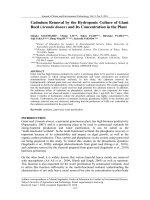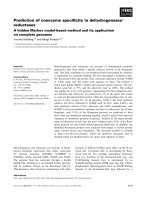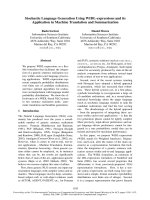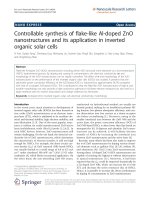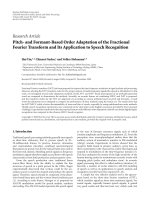Further development of local MQ DQ method and its application in CFD
Bạn đang xem bản rút gọn của tài liệu. Xem và tải ngay bản đầy đủ của tài liệu tại đây (12.32 MB, 203 trang )
FURTHER DEVELOPMENT OF LOCAL MQ-DQ
METHOD AND ITS APPLICATION IN CFD
SHAN YONGYUAN
(B. Eng., Xi’an Jiaotong University, China)
A THESIS SUBMITTED
FOR THE DEGREE OF DOCTOR OF PHILOSOPHY
DEPARTMENT OF MECHANICAL ENGINEERING
NATIONAL UNIVERSITY OF SINGAPORE
2010
i
Acknowledgements
I would like to express my deepest gratitude to my supervisor, Professor C. Shu,
for his invaluable guidance, suggestions and patience throughout this study. His
support and encouragement have contributed much towards the formation and
completion of this dissertation.
I would also like to express my gratitude to all the staff members in the Fluid
Mechanics Laboratory for their constant help and excellent service.
My gratitude also extends to my wife and my parents, whose support, patience
and encouragement made it possible for me to complete this contribution.
Finally, I wish to express my appreciation to National University of Singapore for
providing me with research scholarship, which makes this study possible.
ii
Table of Contents
Acknowledgements…………………………………………………………… i
Table of Contents……………………………………………………………… ii
Summary………………………………… ………………………………….viii
List of Tables………………………………………………………………… xi
List of Figures……………………………………………………………… xii
Nomenclature………………………………………………………………….xvi
Chapter 1 Introduction…………………………………………………… 1
1.1 Background…………………………………………………………… 1
1.1.1 Traditional numerical methods………………………………… 1
1.1.2 Mesh-free methods…………………………………………… 3
1.2 Literature review on function and derivative approximation by RBFs 4
1.2.1 Radial basis functions (RBFs)………………………………… 4
1.2.2 Interpolation by MQ RBFs………… ………………………….5
1.2.3 Kansa’s MQ collocation method for solving PDE … 9
1.2.4 Drawbacks of MQ collocation method…… ………………….13
1.2.5 Local MQ-DQ method…………………………………………15
1.2.5.1 Differential quadrature (DQ) method……………………15
1.2.5.2 Local MQ-DQ method………………………………… 16
iii
1.3 Objective of this thesis……………………………………………… 18
1.3.1 Motivations…………………………………………………….18
1.3.2 Objectives………………………………………………………19
1.4 Organization of this thesis…………………………………………….20
Chapter 2 Governing Equations and Solution Methods…………… 22
2.1 Governing equations for incompressible viscous fluid flows……… 22
2.1.1 Primitive variable formulation………………………………….23
2.1.2 Stream function-vorticity formulation………………………….24
2.2 Solution methods…………………………………………………… 26
2.2.1 Spatial discretization method: local MQ-DQ method………….26
2.2.2 Temporal discretization method……………………………… 30
Chapter 3 Multiquadric Finite Difference (MQ-FD) Method and Its
Application…………………
……………………………………….33
3.1 Motivation of this work……………………………………………….33
3.2 Description of MQ-FD Methods and Comparison with Central FD
Schemes………………………………………………………………34
3.2.1 MQ-FD method in 1-D space………………………………… 35
3.2.2 MQ-FD method in 2-D space………………………………… 41
3.3 Performance Study of MQ-FD Methods for Derivative Approximation
and Solution of Poisson Equations………………………………… 44
iv
3.3.1 Derivative approximation of the MQ-FD method in 1-D space.44
3.3.2 Application for solution of Poisson equations in 2-D space… 46
3.4 Simulation of Lid-driven Flow in a Square Cavity……………………48
3.5 Conclusions……………………………………………………………51
Chapter 4 Local MQ-DQ based Stencil Adaptive Method and Its
Application
…………………………………………………………….67
4.1 Motivation of this work……………………………………………….67
4.2 Adaptive mesh refinement techniques……………………………… 68
4.2.1 Literature review……………………………………………… 68
4.2.2 An efficient stencil adaptive algorithm…………………………69
4.3 Development of a local MQ-DQ based stencil adaptive method…… 71
4.3.1 Finite difference based stencil adaptive algorithm…………… 71
4.3.1.1 Criteria for stencil refinement/coarsening……………….72
4.3.1.2 Stencil refinement algorithm…………………………….73
4.3.1.3 Local stencil coarsening…………………………………74
4.3.2 Local MQ-DQ based stencil adaptive method…………………75
4.4 Numerical Experiments………………………………………………78
4.4.1 Comparison with analytical solution of the Poisson equation…79
4.4.2 Natural convective heat transfer in a concentric annulus between
a square outer cylinder and a circular inner cylinder………….81
4.4.2.1 Governing equations and boundary conditions……… 81
v
4.4.2.2 Results and discussion…………………………………84
4.5 Conclusions……………………………………………………………87
Chapter 5 Hybrid FD and Meshless Local MQ-DQ Method for
Simulation of Viscous Flows around a Cylinder
……………….….97
5.1 Motivation of this work……………………………………………….97
5.2 Hybrid FD and Meshless Local MQ-DQ Method…………………100
5.2.1 Local MQ-DQ method………………………………………100
5.2.2 Conventional FD scheme……………………………………100
5.2.3 Hybrid FD and meshless local MQ-DQ method……………102
5.3 Choice of Shape Parameter c in Local MQ-DQ Method…………103
5.4 Simulation of Steady and Unsteady Flows past a Circular Cylinder 107
5.4.1 Governing equations and boundary conditions………………108
5.4.2 Definition of lift and drag coefficients ……………………… 110
5.4.3 Efficiency comparison between present method and the fully
local MQ-DQ method……………………………………… 111
5.4.4 Simulation of steady flow at low Reynolds numbers…………112
5.4.5 Simulation of unsteady flow at moderate Reynolds numbers 113
5.5 Concluding Remarks…………………………………………………115
Chapter 6 Application of Local MQ-DQ Method to Solve 3D
Incompressible Viscous Flows with Curved Boundary…… ….126
vi
6.1 Motivation of this work……………………………………………126
6.2 Error Estimates of the 3D Local MQ-DQ Method…………………128
6.2.1 Relationship between numerical error and number of supporting
points………………………………………………………….131
6.2.2 Relationship between numerical error and free shape
parameter c…………………………………… ………………132
6.3 Numerical Procedure for Simulating Flows past a Sphere…………133
6.3.1 Hybrid FD and local MQ-DQ method……………………… 133
6.3.2 Governing equations………………………………………… 135
6.3.3 Fractional step method……………………………………… 136
6.3.4 Implementation of boundary conditions………………………138
6.3.5 Solution procedure…………………………………………….141
6.3.6 Calculation of drag coefficient
D
C ………………………… 142
6.3.7 Results and Discussion……………………………………… 144
6.3.7.1 Steady axisymmetric flow………………………………….145
6.3.7.2 Steady non-axisymmetric flow…………………………… 146
6.4 Lid-driven flow in a cubic cavity with a stationary, rigid sphere at its
centre……………………………………………………………… 147
6.5 Conclusions………………………………………………………… 151
Chapter 7 Conclusions and Recommendations……………………….170
7.1 Conclusions………………………………………………………… 170
vii
7.2 Recommendations on future work………………………………… 174
Bibliography……………………………………………………………… 176
List of Publications………………………………………………………….185
viii
Summary
In the past two decades, a group of mesh-free methods were developed based on
radial basis functions (RBFs). Local multiquadric-differential quadrature (MQ-DQ)
method is a newly developed method which falls into this group. Compared with
other RBF methods, the local MQ-DQ method mainly has two advantages. First, it
is a local method, which makes it feasible to solve large scale problems. Second, it
is based on derivative approximation instead of function approximation. Thus it
can be well applied to both linear and nonlinear problems. The effectiveness of
this method has been proven by its applications to various kinds of fluid flow
problems. However, the research on the local MQ-DQ method is still in the
preliminary stage. More work is required to further reveal its basic properties and
improve its performance in solving fluid flow problems.
In this thesis, we firstly derived the formulas for the finite difference (FD)
schemes based on the MQ function approximation instead of the low order
polynomial approximation and named them as MQ-FD methods, which can be
considered as special cases of the local MQ-DQ method. The effect of the shape
parameter c in MQ on the formulas of the MQ-FD methods is analyzed. One
interesting observation is that when c goes to infinity, the MQ-FD formulas of
derivative approximation are the same as those given by the conventional FD
ix
schemes. Another observation is that as compared with the conventional FD
schemes, the MQ-FD methods may solve periodic boundary value problems more
accurately. However, for general boundary value problems, the accuracy may not
be as high as that using the conventional FD schemes.
Secondly, this thesis focused on improving the flexibility and efficiency of the
local MQ-DQ method. An efficient local stencil adaptive algorithm was developed
and combined with the local MQ-DQ method. The combined method bears the
properties of both local MQ-DQ method for mesh-free numerical discretization
and local stencil adaptive algorithm for high computational efficiency. Moreover,
a hybrid technique which combines this mesh-free method with conventional FD
scheme was adopted to further improve its efficiency. In this technique, the local
MQ-DQ method is applied for the spatial discretization in the region around the
curved boundary while conventional FD scheme is applied in the rest of the flow
domain taking advantage of its high computational efficiency.
Finally, the local MQ-DQ method was extended to simulate fluid flow problems
with curved boundary in three-dimensional (3D) space. An error estimate was
provided for the 3D local MQ-DQ method to study the influence of shape
parameter and the number of supporting points on its numerical accuracy. It was
observed that the convergence rate can be improved by increasing the number of
supporting points. The problem of flow past a sphere was simulated by the 3D
x
local MQ-DQ method to demonstrate its capability and flexibility in solving 3D
fluid flow problems with curved boundary. The obtained numerical results showed
that it is a promising scheme for solving 3D fluid flow problems with curved
boundary.
xi
List of Tables
Table 4.1 Numerical results of the adaptive Poisson solver………………… 88
Table 4.2 Comparison of
max
ϕ
and Nu for
2.5 ratioAspect
=
,
5
10 Ra = ,
71.0Pr = …………………………………………………….……….88
Table 5.1 Efficiency comparison between local MQ-DQ method and present
method for
20Re = …………………….……………………… 116
Table 5.2 Comparison of length of the recirculating region (
sep
L
), separation
angle (
sep
θ
) and drag coefficient (
d
C ) for Re = 10, 20 and
40…………………………………………………………………116
Table 5.3 Comparison of drag coefficient and lift coefficient for
100Re = 117
Table 5.4 Comparison of drag coefficient and lift coefficient for
200Re = 110
Table 6.1 Mean value of convergence rate with shape parameter 2.0=c … 152
Table 6.2 Mean value of convergence rate with number of supporting points
32
=
s
n …………………………………………………………….153
Table 6.3 Comparison of recirculating length and drag coefficient for Re=50,
100, 150 and 200…………………………………………….…….154
Table 6.4 Comparison of the position of vortex centre of lid-driven cavity flow
with Re=20……….………………………………………… ……155
xii
List of Figures
Figure 2.1 Supporting points around a reference point……………………… 28
Figure 3.1 A supporting region for point
i in 1-D space…………………… 53
Figure 3.2 A supporting region for point
i in 2-D space…………………… 53
Figure 3.3 Effect of shape parameter
c and mesh spacing h on the coefficient of
formula for first order derivatives……………………………… 54
Figure 3.4 Effect of shape parameter
c and mesh spacing h on the coefficient of
formula for second order derivatives……………………… …… 55
Figure 3.5 Derivative approximation of )sin( x
π
by the central FD method and
the MQ-FD method………………………………………… …….56
Figure 3.6 Derivative approximation of
4
x by the central FD method and the
MQ-FD method………………………………………… ……… 57
Figure 3.7 Comparison of accuracy between the MQ-FD method and the central
FD method for solution of Poisson equations……………… …….58
Figure 3.8 Convergence rate of the MQ-FD methods with different shape
parameters for solution of Poisson equation…………………… 59
Figure 3.9 Configuration of a lid-driven flow in a square cavity…………… 60
Figure 3.10 Local u-velocity profile along vertical centerline at
Re 1000= …61
xiii
Figure 3.11 Local v-velocity profile along horizontal centerline at
Re 1000= …………………………………………………… 62
Figure 3.12 Contours of lid-driven cavity flow at
1000Re
=
……………… 63
Figure 3.13 Local u-velocity profile along vertical centerline at
Re 5000= …64
Figure 3.14 Local v-velocity profile along horizontal centerline at
Re 5000= …………………………………………………… 65
Figure 3.15 Contours of lid-driven cavity flow at
5000Re
=
……………… 66
Figure 4.1 Configuration of two types of stencils…………………………… 89
Figure 4.2 Configuration of an initial stencil………………………………… 89
Figure 4.3 Stencil refinement from resolution level 0 to 1…………………….90
Figure 4.4 Stencil refinement from resolution level 1 to 2…………………….90
Figure 4.5 Configuration of an initial stencil in complex geometries…………91
Figure 4.6 Injection of grid point
1
1
i ………………………………………… 91
Figure 4.7 Stencil refinement from resolution level 0 to 1…………………….92
Figure 4.8 A one-dimensional array for storing supporting points…………….92
Figure 4.9 Initial eight supporting points for point
i …………………………92
Figure 4.10 Eight supporting points for point
i in resolution level 1……… 92
Figure 4.11 Domain around an airfoil and its background mesh………………93
Figure 4.12 Final node distributions with different highest resolution levels…94
Figure 4.13 Contour of the variable
T
versus the node distribution with
highest resolution level to 5, i.e., 5
max
=
Level ……………… 94
xiv
Figure 4.14 Sketch of physical domain of natural convection between a square
outer cylinder and a circular inner cylinder………………………95
Figure 4.15 Final node distributions with different highest resolution levels…95
Figure 4.16 Isotherms for
71.0Pr
=
,
5
10=Ra
and 6.2
=
rr ………………96
Figure 4.17 Streamlines for
71.0Pr
=
,
5
10=Ra
and 6.2
=
rr …………….96
Figure 5.1 Grid configuration for conventional FD schemes……………… 118
Figure 5.2 Grid distribution with uniform Cartesian mesh points……………119
Figure 5.3 Grid distribution with non-uniform Cartesian mesh points……….120
Figure 5.4 Convergence history of relative error versus shape parameter
c 121
Figure 5.5 Configuration of flow around one isolated cylinder…………… 122
Figure 5.6 A local body-fitted coordinate system…………………………….122
Figure 5.7 Streamlines for Re = 10, 20 and 40……………………………….123
Figure 5.8 The time-evolution of lift and drag coefficients for
100Re = … 124
Figure 5.9 The time-evolution of lift and drag coefficients for
200Re = … 124
Figure 5.10 Streamlines and vorticity contours for
100Re
=
……………….125
Figure 5.11 Streamlines and vorticity contours for
200Re
=
……………….125
Figure 6.1 Numerical errors versus mesh size for various number of supporting
points……………………………………………………………156
Figure 6.2 Numerical errors versus mesh size for various shape parameter c 157
Figure 6.3 Grid point distribution on the x-y plane at
0
=
z ……………… 158
xv
Figure 6.4 Sketch of the enforcement of continuity equation on the solid
boundary………………………………………………………….158
Figure 6.5 Calculated axisymmetric streamlines past the sphere…………….159
Figure 6.6 Pressure contours for axi-symmetric flow……………………… 160
Figure 6.7 Streamlines of projected velocity vectors at Re = 250……………161
Figure 6.8 Pressure contours Re = 250……………………………………….161
Figure 6.9 Grid points on (x-y) plane with z=0………………………………162
Figure 6.10 Streamlines on (x-y) plane at z=0……………………………… 163
Figure 6.11 Streamlines of projected velocity vectors on (x-y) plane……… 164
Figure 6.12 Pressure contours on (x-y) plane……………………………… 165
Figure 6.13 Streamlines of projected velocity vectors on (y-z) plane……… 166
Figure 6.14 Pressure contours on (y-z) plane……………………………… 167
Figure 6.15 Streamlines of projected velocity vectors on (z-x) plane……… 168
Figure 6.16 Pressure contours on (z-x) plane……………………………… 169
xvi
Nomenclature
c Shape parameter in radial basis function
p
C
Specific heat at constant pressure
g Gravitational acceleration
k Thermal conductivity
L Reference length
p Pressure
Pr Prandtl number,
kC
p
/Pr
μ
=
Ra Rayleigh number,
νβρ
kTLgCRa
p
/
3
0
Δ=
Re Reynolds number,
ν
/Re UL
=
T Temperature
t Time
U Reference velocity
u Velocity component along x-direction
v Velocity component along y-direction
w Velocity component along z-direction
x Cartesian coordinate
y Cartesian coordinate
z Cartesian coordinate
β
Thermal expansion coefficient
xvii
μ
Dynamic viscosity
ν
Kinematic viscosity
0
ρ
Reference density
ψ
Stream function
ω
Vorticity
1
Chapter 1 Introduction
1.1 Background
In computational fluid dynamics (CFD), the most popular numerical approaches
used are finite difference (FD), finite volume (FV) and finite element (FE)
methods. Many other methods are developed based on these three methods, which
are thus regarded as traditional numerical methods. Despite the popularity of
traditional methods, a number of new numerical schemes, such as mesh-free
methods, have been developed in the past few decades. In the following, the
traditional FD, FV, FE methods and the recently-developed mesh-free methods are
briefly described.
1.1.1 Traditional numerical methods
FD method may be the oldest method for numerical solution of partial differential
equations (PDEs). It could also be the easiest method for numerical computation.
The fundamental idea of FD method is to approximate/interpolate the unknown
functions by a local Taylor series expansion or polynomial fitting at grid points in
the adopted mesh system. In practical implementations, the FD method essentially
approximates the derivatives in the governing equations by a linear combination
of values of dependent variables at a finite number of grid points along one line.
Therefore, the most suitable computational domain for the FD method is the
regular rectangular type, where it is accurate, efficient and simple to implement.
2
However, it does not adapt well to problems with complex geometry without
appropriate coordinate transformation.
As compared with the FD method, FV method can accommodate any type of grid,
so it is suitable for complex geometries. The FV method uses the integral form of
the conservation equations as its starting point. The solution domain is subdivided
into a finite number of contiguous control volumes, and the conservation
equations are applied to each control volume. At the centroid of each control
volume lies a computational node at which the variable values are to be calculated.
Interpolation is used to express variable values at the control volume surface in
terms of the nodal values. Surface and volume integrals are approximated using
suitable quadrature formulae. As a result, one obtains an algebraic equation for
each control volume, in which a number of neighboring nodal values appear.
Since all terms that need be approximated in the FV method have physical
meaning, it is very popular with engineers. As compared with the FD method, the
disadvantage of the FV method appears in the three-dimensional applications, in
which it is difficult for the FV method to achieve the accuracy of order higher than
the second.
The FE method is similar to the FV method in many ways, except that the FE
method solves the weak form of the partial differential equations. The solution
domain is divided into a set of finite elements, which are generally unstructured to
3
fit the complex geometry. After its initial development from an engineering
background, FE method has been formulated by mathematicians into a very
elegant and strict framework, in which precise mathematical conditions for the
existence of solution and convergence criteria and error bounds were well
established. To fully understand the aspects of finite element discretization,
appropriate mathematical background is needed for the end-users, such as
functional analysis. The greater complexity of the FE method makes it more costly
than the FD method in terms of computational cost.
1.1.2 Mesh-free methods
In recent decades, many new numerical schemes have been proposed to avoid the
weakness of traditional numerical methods. Among them, a group of so-called
mesh-free methods have especially attracted the attention of researchers.
Mesh-free methods are a group of methods which can construct functional
approximation or interpolation entirely from the information at a set of scattered
nodes, among which there is no pre-specified connectivity or relationship. This
means that they only require node generation instead of mesh generation, thus the
computational costs associated with mesh generation are highly reduced,
especially for problems with complex geometry. Another key advantage of
mesh-free methods is the computational ease of adding and subtracting nodes
from the pre-existing nodes. This property is particularly important for solving
flow problems with large deformation or moving boundaries.
4
A number of mesh-free methods have been proposed up to now. Among them, a
group of mesh-free methods, which are based on the so-called radial basis
functions (RBFs), have received increasing attention by researchers in the past
two decades. RBFs are a primary tool for interpolating multi-dimensional
scattered data. Due to their “mesh-free” property, RBFs were adopted to deal with
PDEs in recent years. In the following section, we will give a literature review on
the development of RBFs methods, especially for multiquadric (MQ) RBFs.
1.2 Literature review on function and derivative approximation
by RBFs
1.2.1 Radial basis functions (RBFs)
A radial basis function is a continuous spline which depends on the separation
distances of a subset of scattered points. There are many RBFs available. The
most commonly used RBFs are
Multiquadrics (MQ):
22
)( crr +=
ϕ
(1.1a)
Thin-plate splines (TPS): )log()(
2
rrr =
ϕ
(1.1b)
Gaussians:
2
)(
cr
er
−
=
ϕ
(1.1c)
Inverse multiquadrics (MQ):
22
1
)(
cr
r
+
=
ϕ
(1.1d)
where
2
j
r xx −=
and shape parameter c is a positive constant.
Among the above popular RBFs, the Gaussian and the inverse MQ are positive
5
definite functions, while the MQ and the TPS are conditionally positive definite
functions. From the test result of interpolation by Franke (1982), it was found that
MQ obtained the best solution in accuracy, and TPS ranked the second. However,
though TPS RBFs have been considered as one of the optimal functions for
multivariate data interpolation, they do only converge linearly (Powell, 1994).
Compared to TPS RBFs, the MQ functions can converge exponentially and
always produce a minimal semi-norm error (Madych, 1990).
1.2.2 Interpolation by MQ RBFs
The multiquadric (MQ) interpolation method was first developed by Hardy (1971)
to produce topographic maps based upon elevations at arbitrarily located points in
a plane. Hardy’s basic scheme is very simple and easy to implement. It is assumed
that any function, f, may be written as an expansion of N continuously
differentiable radial basis functions, g:
∑
=
−=
N
j
jjj
gaf
1
)()( xxx
(1.2)
where
22
)()( cdg
jjjj
+−=− xxxx (1.3)
2
c
is a non-zero input parameter, and
⋅⋅⋅+−+−=−
222
)()()(
jjjj
yyxxd xx
(1.4)
The basis functions for MQ method consist of the sum of the square of the
Euclidean distance between a data point and the evaluation point, and a
non-negative parameter
2
c
. The value of
2
c
controls the shape of the basis
6
function. Large
2
c
values give rise to flat sheet-like basis functions, intermediate
2
c
values give rise to bowl-like basis functions and small
2
c
values give rise to
narrow cone-like basis functions.
The coefficients
}{
j
a
are found by solving a set of linear equations in terms of
the basis functions.
NiFga
i
N
j
jijj
,,2,1),()(
1
==−
∑
=
xxx
(1.5)
and )()(
ii
Ff xx = which are given.
The MQ method was applied successfully in various early applications, but it was
almost unknown by mathematicians. This situation was changed when Franke
(1982) published a review paper which evaluated 29 different algorithms for the
scattered data interpolation problem on a variety of known data surfaces. Franke
graded various scattered data interpolation schemes according to the following
criteria: accuracy, visual aspect, sensitivity to parameters, execution time, storage
requirements and ease of implementation. Franke stated that of all the methods
tested, Hardy’s MQ method (1971) gave the most accurate results. The second
best interpolation method was the thin-plate spline of Duchon (1976).
Consequently, the MQ method began to be popular among researchers.
Stead (1984), like Franke (1982), examined various methods for estimating partial
derivatives on scattered data. She concluded that for surfaces with large curvature,
7
MQ is excellent for obtaining very accurate derivative estimates, but that MQ
behaves poorly on relatively flat surfaces. She therefore recommended a
combination of techniques in which MQ would be applied to steep surfaces and a
quadratic fit would be used for relatively flat surfaces without using
transformations such as stretching functions which cause a change in geometry.
Madych and Nelson (1990) considered a general class of interpolants which
includes a polynomial of degree less than some fixed integer m given by
∑∑
<=
+−=
m
xxxx
α
α
α
kgaf
N
j
jj
1
)()( , (1.6)
where
j
a
and
α
k must satisfy
iii
N
j
jij
Ffkga ==+−
∑∑
<=
)()(
1
xxxx
m
α
α
α
, } ,,2,1{ Ni
=
, (1.7a)
0
1
=
∑
=
N
j
jj
a
α
x
, m<
α
. (1.7b)
This type of MQ interpolant can achieve polynomial precision.
The mathematical analysis of MQ is very difficult, and it is not known why MQ
performs so well. Initially, many mathematicians found the MQ method to be
enigmatic, counter-intuitive, and difficult to analyze. Later, several theoretical
advances have been established. Micchelli (1986) proved that the linear system
obtained from the interpolation conditions is always solvable for distinct data. He
has shown that MQ coefficient matrix of rank N has one positive real eigenvalue
and (N-1) negative real eigenvalues. Furthermore, he has shown that Duchon’s
